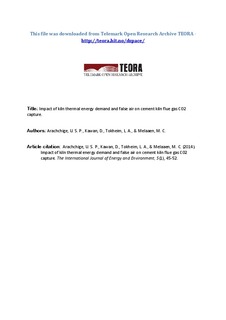Impact of kiln thermal energy demand and false air on cement kiln flue gas CO2 capture
Journal article, Peer reviewed
Published version
Permanent lenke
http://hdl.handle.net/11250/2438579Utgivelsesdato
2014Metadata
Vis full innførselSamlinger
Originalversjon
Arachchige, U. S. P., Kawan, D., Tokheim, L. A., & Melaaen, M. C. (2014). Impact of kiln thermal energy demand and false air on cement kiln flue gas CO2 capture. The International Journal of Energy and Environment, 5(1), 45-52.Sammendrag
The present study is focused on the effect of the specific thermal energy demand and the false air factor on carbon capture applied to cement kiln exhaust gases. The carbon capture process model was developed and implemented in Aspen Plus. The model was developed for flue gases from a typical cement clinker manufacturing plant. The specific thermal energy demand as well as the false air factor of the kiln system were varied in order to determine the effect on CO2 capture plant performance, such as the solvent regeneration energy demand. In general, an increase in the mentioned kiln system factors increases the regeneration energy demand. The reboiler energy demand is calculated as 3270, 3428 and 3589 kJ/kg clinker for a specific thermal energy of 3000, 3400 and 3800 kJ/kg clinker, respectively. Setting the false air factor to 25, 50 or 70% gives a reboiler energy demand of 3428, 3476, 3568 kJ/kg clinker, respectively.

